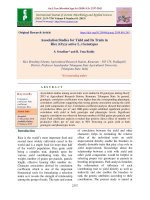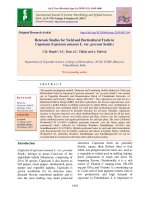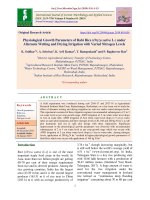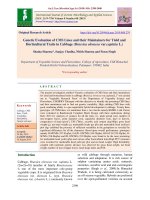Estimation of genetic parameters for yield and related traits in advanced recombinant lines of Kalanamak rice (Oryza sativa L.)
Bạn đang xem bản rút gọn của tài liệu. Xem và tải ngay bản đầy đủ của tài liệu tại đây (360.43 KB, 8 trang )
Int.J.Curr.Microbiol.App.Sci (2019) 8(9): 2052-2059
International Journal of Current Microbiology and Applied Sciences
ISSN: 2319-7706 Volume 8 Number 09 (2019)
Journal homepage:
Original Research Article
/>
Estimation of Genetic Parameters for Yield and Related Traits in Advanced
Recombinant Lines of Kalanamak Rice (Oryza sativa L.)
Banshidhar1*, Priyanka Jaiswal2, Mithilesh Kumar Singh3 and Indra deo4
Genetics and Plant Breeding, GBPUAT, Pantnagar, Uttarakhand, India
*Corresponding author
ABSTRACT
Keywords
Kalanamakrice,
Variability,
Heritability,
Genetic Advance,
GAM, RCBD
Article Info
Accepted:
20 August 2019
Available Online:
10 September 2019
The present investigation was undertaken with the objectives to assess variability,
heritability, genetic advance and genetic advance as percentage of mean (GAM)in 11
advanced recombinant lines of Kalanamak rice for fifteen quantitative traits. Trials
were conducted for two seasons during wet season of 2016 and 2017 at Norman E.
Borlaug Crop Research Centre (NEBCRC), G. B. Pant University of Agriculture and
Technology (GBPUAT), Pantnagar, Uttarakhand in a Randomized Complete Block
Design (RCBD) with three replications with the spacing of 20 cm × 15 cm and the
recommended cultural practices were followed. The data were analyzed for using
OPSTAT statistical software. Over the year high GCV and PCV was observed fortest
weight (23.36 g and23.82 g) and grain yield (21.28 g and 21.88 g). Highest heritability
was observed for weight of 1000 grains (96.02%) while lowest heritability was
observed for days to maturity (27. 34%). Genetic advance as percentage of mean was
observed highest for test weight(47.20 %) and lowest for days to maturity (1.01%).
High heritability coupled with high genetic advance as percentage of mean was
observed for test weight(96.20%& 47.21%) followed by stem thickness (95.36%&
24.60%) and yield (94.55%& 42.62%) indicating their usefulness in indirect selection
to improve yield.
Introduction
Rice (Oryza sativa L.)caters to the dietary need
ofalmost half of the global population
(CGIAR, 2012).It is the staple food in
Asiaticregion whereabout 90% of global rice is
produced and about 75% thereof is consumed.
Globally, it is cultivated over an estimated area
of 160.10 million hectares producing about
483.80 million tons of grains(USDA,2017). In
India, rice is cultivated over an area of 43.38
million hectares producing 104.32 million tons
of grains with an average productivity of 2404
kg/ha
(DAC&FWAnnual
report,20152016).Basmati and Non- Basmati aromatic rice
has played a significant role in boosting rice
economy through earning foreign exchange.
Among the aromatic varieties Kalanamak is
one of the finest quality rice cultivated in
India.It derives its name from black husk of
kernel (Kala) and its ability to successfully
adapt inusar soils characterized by high salt
2052
Int.J.Curr.Microbiol.App.Sci (2019) 8(9): 2052-2059
concentration and high pH and/or having a
distinctive salty taste (Namak). Except for
grain length, Kalanamak rice outshines even
the most demanded Basmati rice in rest of the
quality parameters. But, the Kalanamak rice
succumbs to various biotic and abiotic stresses.
Hence, there is an imperative need to develop
improved genotypes that can withstand these
stresses. Towards this end it is desirable to
study genetic variability, heritability and
genetic advance for seed yield and yield
contributing traits that will further assist in
breeding improved rice genotypes with high
yield potential coupled with multiple
resistances biotic and abiotic stresses.
flag leaf width from penultimate row was
measured on 10 plants at booting stage. Stem
thickness was measured on same 10 plants at
milk development stage. Data for stem length
and panicle length of main axis was recorded
at milk development stage. Panicles per plant
were counted on 10 plants at dough
development stage. 1000 fully developed and
matured grains from composite sample of each
entry were weighed using electronic balance at
hard caryopsis stage to record weight of 1000
grains. Grain length and kernel length were
recorded by placing 10 grains length wise and
width wise just adjacent to one another,
respectively, on graph paper and measuring the
distance between first and last grain and
For selecting such improved genotypes from kernel. The procedure defined by (Juliano,
diverse genetic stock a clear understanding and 1971) was used to determine the content of
scientific knowledge on existing variability, amylose in endosperm. The mean values
heritability and the expected genetic advance is computed from the observations for each
necessary. Therefore, the present study was replication were used for statistical analysis.
conducted with the aim to estimate variability
and other relevant genetic parameters for yield Biometrical analysis
and yield contributing traits so that the
information gained can further be applied in The pooled data over two years for various
genetic improvement of Kalanamak rice.
traits were analyzed. The partitioning of the
total variance assignable to different sources
viz.Genotypic coefficients of variation (GCV)
Materials and Methods
and Phenotypiccoefficients of variation (PCV)
The present investigation was conducted on (Burton, 1952), heritability (broad sense),
eleven Kalanamak Advanced Recombinant genetic advance and expected genetic advance
Lines of rice along with the reference variety as percent of mean(Allard,1960). The GCV
Pant Sugandh Dhan 17.
and PCV values were ranked as low, medium
and high (Sivasubramanian and Menon, 1973).
The entries were evaluated in Randomized Heritability in broad sense was categorized as
Complete Block Design (RCBD) with three low, moderate and high (Robinson et al.,
replications
at
NEBCRC,
GBPUAT, 1949). Genetic advance as percentage of mean
Pantnagar, Uttarakhand, during wet season of was categorized as low moderate and high as
2016 and 2017. The recommended packages of given by (Johnson et al.,1955).
agronomic practices were followed throughout
the crop growth period.
Results and Discussion
Sampling and observed traits
Analysis of Variance (ANOVA)
Data were scored for measureable traits The analysis of variance (ANOVA) showed
following DUS guidelines. Flag leaf length and that sufficient genetic variability exists for all
2053
Int.J.Curr.Microbiol.App.Sci (2019) 8(9): 2052-2059
the studied traits (Table 1) providing
opportunity to alter the trait in desirable
direction through selection. Phenotypic
Coefficient of Variations (PCV) was slightly
higher than Genotypic Coefficient of Variation
(GCV) for all the studied traits, indicating that
the traits were less influenced by the
environment. Therefore, selection on the basis
of phenotype alone can be effective for the
improvement of these traits. Over the year
2016 and 2017high GCV and PCV was
observed for weight of 1000 grains
(23.36&23.82) and grain yield (21.28&21.88).
medium GCV and PCV was observed for
length of leaf blade (14.32 &15.38), width of
leaf blade (19.42&20.49), stem thickness
(12.23 &12.53) and number of panicle per
plant (11.14 &12.25) and low GCV and PCV
was observed for time of heading (2.24
&3.25), stem length (6.83 &7.02), panicle
length (9.26 &9.50), days to maturity (0.94
&1.80), grain length (4.52 &5.65), grain width
(5.38 &6.71), decorticated grain length (8.11 &
8.95), decorticated grain width (8.76 &9.55)
and amylase content (3.08 &3.29). Genotypic
coefficient of variation provides information
on the extent of genetic variability present in
any quantitative trait but it, solely, can not
predict the heritability of trait. Heritability
measures the fraction of phenotype variability
that can be attributed to genetic variation.
Therefore, high heritability helps in effective
selection for a particular character. Heritability
in broad sense [h2(bs)]calculated for various
traits are presented in Table 2.Highest
heritability was observed for weight of 1000
fully developed kernel (96.02%) followed by
stem thickness (95.37%), panicle length
(95.16%), stem length (94.63%), grain yield
(94.55), width of leaf blade (89.82%), amylose
content (87.93%),length of leaf blade
(86.71%), decorticated grain width (84.10%),
panicle number plant-1 (82.75 %), decorticated
grain length (81.99%), grain width (64.42%)
and grain length (63.89%). High heritability
for these traits demonstrated that these traits
could be successfully transferred to offspring,
and selection for such trait is easy and quick.
These traits can also be used for indirect
selection of some other correlated characters
that have low heritability and complex
inheritance. Based upon variability and
heritability estimates, it could be concluded
that improvement by direct selection in rice is
possible for traits like weight of 1000 fully
developed kernel, stem thickness, panicle
length, stem length, grain yield, width of leaf
blade, amylose content, length of leaf blade,
decorticated grain width, panicle number per
plant, decorticated grain length, grain width
and grain length. Moderate heritability was
observed for time of heading (47.31%) while
the low heritability was observed for time of
maturity (27. 34%).Selection for low heritable
traits is not effective.
Genetic advance is the mean genotypic
improvement of selected individuals over the
parental population. The genetic advance is a
useful indicator of the progress that can be
expected as a result of exercising selection on
the pertinent population (Vanniarajan et al.,
1996). High heritability with high genetic
advance considered together should be used in
predicting the ultimate effect of selecting
superior varieties (Ali et al., 2002).Highest
genetic advance as percentage of mean was
observed for weight of 1000 fully developed
kernels (47.20 %) followed by yield (42.61%),
width of leaf blade (37.90%), length of leaf
blade (27.46%), stem thickness (24.50%) and
panicle number plant-1 (20.88%).Moderate
genetic advance as percentage of mean was
observed for panicle length (18.61),
decorticated
grain
width
(16.54%),
decorticated grain length (15.11%) and stem
length (13.68%).Low genetic advance as
percentage of mean was observed for grain
width (8.90%), grain length (7.44%), amylose
content (5.95%), and time of heading (3.16%)
and lowest genetic advance as percentage of
mean was observed for days to maturity
(1.01%).
2054
Int.J.Curr.Microbiol.App.Sci (2019) 8(9): 2052-2059
Table.1 ANOVA, Genotypic and Phenotypic variance for different traits in Kalanamak Rice
S.No.
Character
1
2
3
4
5
6
7
8
9
10
11
12
13
14
15
df
Leaf: Length of blade (cm)
Leaf: Width of blade(cm)
Time of 50 % heading (days)
Stem thickness (cm)
Stem length of main stem (cm)
Panicle: Length of main axis (cm)
Panicle: Number per plant
Time of maturity (days)
Test weight(g)
Grain: Length (mm)
Grain: Width (mm)
Decorticated grain: Length (mm)
Decorticated grain: Width (mm)
Endosperm: amylose content
Yield (g/6m2 )
Mean sum of squares
Replication Treatment
2
11
Error
22
1.44
0.00
14.78
0.01
6.86
1.00*
1.36*
18.08
1.14
0.00
0.00
0.00
0.00
7974.52**
1.44
3.08
0.01
11.57
0.00
4.38
0.27
0.30
7.24
0.41
0.00
0.00
0.00
0.00
953.07
3.08
63.36**
0.14**
42.71**
0.26**
235.86**
16.36**
4.62**
15.40
31.24**
0.00**
0.00
0.01**
0.00
50584.57**
63.36**
*, **: Significant at 5% and 1% probability levels, respectively
2055
Genotypic
variance
Phenotypic
variance
20.09
0.05
10.38
0.09
77.16
5.36
1.44
2.72
10.28
0.00
0.00
0.00
0.00
16543.83
266549.40
23.17
0.05
21.95
0.09
81.54
5.64
1.74
9.96
10.68
0.00
0.00
0.00
0.00
17496.91
269325.50
Int.J.Curr.Microbiol.App.Sci (2019) 8(9): 2052-2059
Table.2 Phenotypic coefficient of variation (PCV), genotypic coefficient of variation (GCV), Heritability (h2),genetic advance (GA)
and Genetic Advance as (%) of means (GAM)for different traits in Kalanamak Rice.
Characters
Leaf: Length of blade (cm)
Genotypic
Coefficient of
Variation
(GCV)
14.32
Phenotypic
Coefficient of
Variation
(PCV)
15.38
Leaf: Width of blade(cm)
19.42
Time of 50 % heading (days)
86.71
8.60
Genetic
Advance
as (%) of
Means
27.47
20.49
89.82
0.42
37.90
2.24
3.25
47.31
4.57
3.17
Stem thickness (cm)
12.23
12.53
95.37
0.60
24.61
Stem length of main stem (cm)
6.83
7.02
94.63
17.60
13.69
Panicle: Length of main axis (cm)
9.26
9.50
95.16
4.65
18.62
Panicle: Number per plant
11.14
12.25
82.75
2.25
20.88
Time of maturity (days)
0.94
1.80
27.34
1.78
1.01
Test weight (g)
23.36
23.82
96.20
6.48
47.21
Grain: Length (mm)
4.52
5.65
63.90
0.06
7.44
Grain: Width (mm)
5.38
6.71
64.42
0.02
8.90
Decorticated grain: Length (mm)
8.11
8.95
82.00
0.07
15.12
Decorticated grain: Width (mm)
8.76
9.55
84.10
0.03
16.54
Endosperm: Content of amylose
3.08
3.29
87.93
1.25
5.95
Yield (g/6m2 )
21.28
21.88
94.55
257.65
42.62
2056
Heritability Genetic
(%)
Advance
(GA)
Int.J.Curr.Microbiol.App.Sci (2019) 8(9): 2052-2059
Fig.1
High heritability coupled with high genetic
advance as percentage of mean was observed
for weight of 1000 grains(96.20 &
47.21),stem thickness (95.36 & 24.60), yield
(94.55 & 42.62),flag leaf width (89.81 &
37.40), flag leaf length (85.70 & 27.46) and
panicles per plant (82.75 & 20.87).This
suggests for rapid improvement in the
character due to selection and these
characters can be further improved by
following simple selection procedure. This
also suggests that these traits were controlled
by additive type of gene action in the
inheritance of these characters, the low
estimates of genetic advance as percent of
mean for time of heading with 50% panicles
(3.16) and days to maturity (1.01) indicated
the presence of non-additive gene effects, in
addition to influence of environment to some
extent. Similar result was reported by (Prasad
et al.,2017). These traits can be improved by
intermating superior
genotypes
from
segregating population developed from
combination breeding.
The salient findings of the present study
Pooled analysis of variance for measurable
characters showed significant variation
among genotypes for all the traits under
2057
Int.J.Curr.Microbiol.App.Sci (2019) 8(9): 2052-2059
study. Grains per panicle and plant height
exhibited highest genotypic and phenotypic
variances, followed by spikelet fertility and
days to 50% flowering.
Drought tolerance in wheat: Genetic
variation and heritability for growth and
ion relations. Asian J. Plant Sci., 1: 420422.
Allard, R.W. 1960. Principles of Plant
Breeding. New York, USA, John Wiley
and Sons Inc. 485 p.
Burton, G. W. 1952. Quantitative inheritance
in grasses. In: Proceedings of
6thInternational Grassland Congress, 1,
America. pp. 277-283.
Burton, G. W. and De Vane, E. W..1953.
Estimating heritability in tall fescue
(Festuca arundinacea) from replicated
clonal material. Agronomy Journal, 45:
478-481.
Johnson, H. W., Robinson, H. F and
Comstock, R. E. 1955. Estimates of
genetic and environmental variability in
soybean. Agronomy Journal.,47 (7): 314318.
Juliano, B. O. 1971. A simplified assay for
milled-rice amylose. Cereal Sci. Today,
16: 334 – 338.
Prasad, R.K., Radhakrishna, K.V., Bhave,
M.H.V. and Subba Rao, L.V. 2017.
Genetic variability, Heritability and
Genetic advance in Boro Rice (Oryza
sativa
L.)
germplasm.
Int.J.Curr.Microbiol.App.Sci.,
6(4):
1261-1266.
Robinson, H.F., Comstock, R.E. and Harvey,
P.H. 1949. Estimation of heritability and
the degree of dominance in corn. Agron.
J.,41: 353-359.
Sivasubramanian, S. and Madhava, M.P.
1973. Genotypic and phenotypic
variability in rice. Madras Agri.Journal,
60: 1093-1096.
Vanniarajan,
C.,
Rangasamy,
P.,
Ramalingam, J., Nadarajan, N. and
Arumngampillai, M. 1996. Studies on
genetic variability in hybrid rice
derivatives. Crop research,12: 24-27.
The insignificant difference between PCV
and GCV indicate that the environment has
very less role in inheritance of these
characters.
Highest heritability was exhibited for all the
traits except time to maturity and time to 50
% heading.
Highest genetic advance as percentage of
mean was observed for weight of 1000 fully
developed kernels followed by yield, width of
leaf blade, length of leaf blade, stem
thickness and panicle number per plant.
High heritability coupled with high genetic
advance as percentage of mean was observed
for 1000 fully developed kernels, yield, width
of leaf blade, length of leaf blade, stem
thickness and panicle number per plant.
Acknowledgement
We duly acknowledge ICAR for financial
support.We also pay our special gratitude to
Director Research, Pantnagar, Dr. P.K. Singh,
Professor, Genetics and Plant Breeding,
BHU, Varanasi and Dr. Rajesh Kumar,
Associate Professor Genetics and Plant
Breeding, Dr. RPCAU, Pusa for their
valuable guidance and generous help at every
step during conduct of experiment.
Funding
The study is financially supported by ICAR
in form of Junior Research Fellowship to the
first author with Grant letter numbered EDN
/1/26/2015
Dated
10/07/2016.
References
Ali, A., Khan, S. and Asad, M.A. 2002.
2058
Int.J.Curr.Microbiol.App.Sci (2019) 8(9): 2052-2059
How to cite this article:
Banshidhar, Priyanka Jaiswal, Mithilesh Kumar Singh and Indra deo 2019. Estimation of
Genetic Parameters for Yield and Related Traits in Advanced Recombinant Lines of
Kalanamak Rice (Oryza sativa L.). Int.J.Curr.Microbiol.App.Sci. 8(09): 2052-2059.
doi: />
2059
![Chemical and functional components in different parts of rough rice (oryza sativa l[1] ) beforeandaftergermination](https://media.store123doc.com/images/document/14/rc/qa/medium_qab1394872940.jpg)








